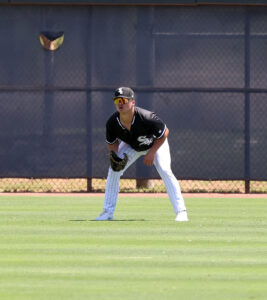Interview with Great Falls Pitching Coach Matt Zaleski
Matt Zaleski was kind enough to take the time to chat with FutureSox about his first season as a pitching coach, his star pupil Alec Hansen, and a few other interesting arms in Great Falls. Zaleski spent 11 seasons in the White Sox system until he retired in 2014 with a career 3.88 ERA over 958.1 professional innings. Here in 2016, the Chicago area native has helped produce by most any measure the best performing pitching staff in the hitter-friendly Pioneer League.
FutureSox: What was it like going from a player in the White Sox organization to coaching kids who could have been your teammates just a year prior?
Matt Zaleski: I thoroughly enjoy coaching. As a player you can put in your hard work and go out to the mound and the results just don’t happen, even if you put in the work for it. As a coach, you put in the work with these guys and can see little stuff happening almost immediately. I’ve found it to be a lot more rewarding.
FS: The White Sox are considered one of the best systems for developing pitchers, all the way up to White Sox pitching coach Don Cooper. How does it feel becoming a part of that?
MZ: I am very grateful for them to give me an opportunity to be a part of a wonderful pitching development program. I had Richard Dotson as a pitching coach for probably 5-6 years of my 11 years playing and J.R. Perdew about the other five. I learned quite from both of them. Not just delivery stuff, but how to read hitters and drills to do with guys. When I came on in instructs, I worked with Curt Hasler and learned a ton of new drills from him. It is outstanding the amount of knowledge these guys have and its awesome to be a part of.
FS: Can you talk about what you’ve been working on with Alec Hansen?
MZ: Funny thing, out of the stretch he uses his slide step and throws the ball downhill to both sides of the plate with that big frame and gets a good angle. He keeps it simple and picks his leg up and goes to home. Out of the wind-up, I think big-bodied guys have a tendency to get lost in their mechanics with a slower tempo. I’ve been working with him on picking up the tempo and keep his direction going towards home plate. Sometimes he loses his top half and leans on his pitches and his arm angle creeps up. Working with myself and Curt Hasler, we’ve got Alec staying back up over the rubber, picking the tempo up, and keeping that posture and the ball away from his head. The nice thing about it is Alec is a very, very coachable kid. I don’t know what history he has had with pitching coaches over his career, but he has been excellent to work with. For example, you could see in his first couple starts here (Great Falls), he was throwing balls around the zone. I wouldn’t say he was commanding his pitches, but he was controlling them. I’ve heard stories of him not being able to throw it near the catcher in college and I didn’t see that at all. He was around the zone and we kept working with him over, and over, and over on repeating that delivery. The difference now is exceptional, especially over his last four or five starts. He was getting a lot of called strikes on fastballs and using that power major league stuff, and if he ahead in the count it is pretty much game over on whatever he wants to throw.
FS: Can you talk about Hansen’s change-up and how that pitch is developing?
MZ: The change-up will take some time with him, we’ve been working on it daily in the sidelines (bullpen sessions). Most of our sessions were fastball/change-up work, with the occasional slider/curveball in there to make sure he doesn’t lose feel for them. The change-up will be big for him, especially at the higher levels [where] he will need to keep hitters off balance. His two breaking balls [slider and curveball] are definite major league pitches. He can throw them for strikes, he can throw them down in the dirt, and out of the zone when he wants to. The change-up for him coming into this off-season will be focal point for him and he should be putting a lot of work into it. He does show a good one, a very very good one at times and it is fun to see that because you know it is there.
FS: MLB.com writer Jim Callis mentioned that something Hansen is on working is “getting the ball out of glove more quickly.” Can you elaborate on that?
MZ: Basically trying to separate those hands, as he is starting to come down and go towards home plate his hands aren’t stuck in his glove. That allows him to have his natural arm path and arm speed move fluidly towards the plate. He doesn’t get stuck behind himself at all and sometimes when pitchers carry their hands too long it causes them to elevating or cutting themselves off and pulling fastballs rather than driving them. It also comes with that tempo thing, if that stuff is going on it slows you down. He has been working hard on it and it has been really, really pleasant to watch.
FS: Can you talk about Yosmer Solorzano and how excited you were for his part in the no-hitter on Saturday?
MZ: I was very, very happy for Yosmer. He had three or four rough starts in a row where he went four or five innings and his pitch count went up there and I had to get him out of the game. It was great to see him command his fastball and his slider was excellent that day, it was one of those starts where everything clicked. He was throwing his fastball down and mixed his speeds effectively. Sometimes when pitchers have a few rough ones in a row, the thought process of a pitching coach is, “should we take him out after five no-hit innings so he can build off that performance?” Or do you let him keep going and risk giving up some runs and hurt his confidence? He kept getting after it and was aggressive and it was awesome to see.
FS: Have you been working on anything specifically with Solorzano?
MZ: He is like a lot of young kids where if he has a change-up, they just need to throw it more. That is one of the bigger things with Yosmer. In his last start I think he threw seven change-ups but in some of his other starts he only throws two or three out of 80-90 pitches. We are just trying to get him to use that more just to keep hitters off balance. If everything is on and working it is pretty nice, but there are days when you don’t have your fastball command and he is going to have to utilize that change-up more for strikes and then the fastball more for effect to change speeds.
FS: Are there any bullpen arms that have been standing out for you?
MZ: We’ve sent two guys to Kannapolis out the bullpen who pitched well for us. Michael Horejsei is a short left-hander who has has good stuff and threw strikes. Also Ben Wright commands his fastball well and has three pretty good pitches. This draft class is pretty good. They definitely did a good job getting some arms. Jake Elliott, teammate of Hansen’s at Oklahoma, has done a good job out of the bullpen for us. Aaron Bummer is a pretty dang good lefty, has power stuff. Jaider Rocha started the year in Kannapolis and we were fortunate to have him here. Lane Hobbs is a tall and big-bodied right-hander.
We’ve got a good staff to work with, it has been a lot of fun. For me, it is about fine-tuning the tools that got them drafted as opposed to getting into specifics about how to pitch certain hitters. I am stressing throwing the ball down in the zone, working both sides of the plate, elevating when you need to, when it is time to throw a breaking ball in a fastball count, things that keep hitters off balance.
Want to know right away when we publish a new article? Type your email address in the box and click the “create subscription” button. Our list is completely spam free, and you can opt out at any time.




